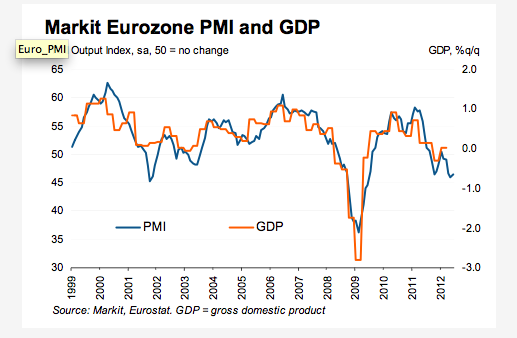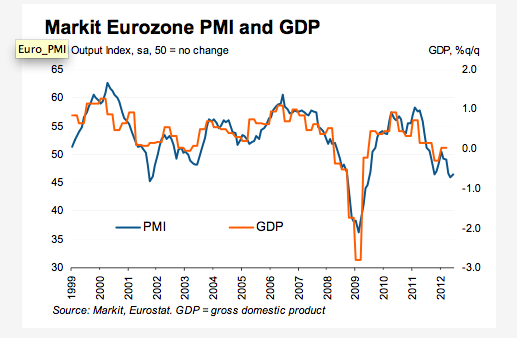By Delusional Economics, who is horrified at the state of economic commentary in Australia and is determined to cleanse the daily flow of vested interests propaganda to produce a balanced counterpoint. Cross posted from MacroBusiness.
As I‘ve been saying over the last few days, last week’s EU summit provided Europe with some political success but actual deliverables are some time off. According to the Finnish PM at least a year. There is already rumbling from a number of countries, including Germany, about what exactly was and wasn’t decided last Friday morning and my suspicious are, as we’ve seen many times before, that final outcomes will be some 17, or 27, headed beast built on layers of political compromise.
In the meantime the implementation of austerity policy across the periphery, and now France it seems, continues to lead to a slowing economy across the monetary union.
Overnight we had yet another tranche of PMI data that once again highlighted the same downward trend.
EuroZone composite PMI – June 2012 Final
Eurozone PMI rises in June but still signals steep rate of contraction
Final Eurozone Composite Output Index: 46.4 (Flash 46.0, May 46.0)
Final Eurozone Services Business Activity Index: 47.1 (Flash 46.8, May 46.7)
Near-record fall in service sector confidenceThe Eurozone economic downturn extended into a fifth consecutive month in June, as the debt and political crises continued to have an adverse impact on both the manufacturing and service sectors.
At 46.4 in June, the Markit Eurozone PMI Composite Output Index was higher than both May’s reading of 46.0 and the earlier flash estimate of 46.0, but still remained deep in contraction territory. The average reading for Q2 2012 was the lowest for three years as a result.
Rates of decline eased marginally in both services and manufacturing, but both sectors have seen the strongest quarterly contractions for three years in the second quarter.
The spreading of the economic malaise from the periphery of the currency union to its core continued in June. German output contracted at the fastest rate in three years, and France also saw a further decline (albeit slower than in May). Italy and Spain, meanwhile, remained in deep recessions.
Detailed reports of individual country’s June service’s PMI were also released with much the same story. Germany‘s service sector stagnated while its business outlook deteriorated markedly. French services activity remained in contraction, declining at slower pace, but business expectations fell to 39-month low. Italy saw further marked decreases in services activity while job shedding accelerated. Spain saw a sharp reduction in business activity, and finally, Ireland‘s service sector activity continued to fall although at nothing like the pace of the southern economies.
So its a very grim picture across the board as this collection of charts shows.
Last December I wrote a follow-up piece on the risks in the French economy in which I stated:
.. France would be next after Italy in the contagion breakdown because of its macroeconomic metrics. High levels of public and private debt, a long running negative trade balance and current account deficit, stalling industrial production, GDP and employment along with significant banking sector exposure to the periphery all add up to a fairly risky predicament. This is certainly not a country that could take on a strict austerity regime without causing itself some significant short-to-medium term economic damage because it is obvious from the metrics that the private sector has been borrowing from both the external and government sectors for a long period of time.
It appears from the data that Italy is now well within the embrace of the crisis and that France is heading in the same direction. Given France’s main trading partners are Germany, Italy and Spain it is very unlikely that a campaign of government austerity is going to reverse that trend, in fact all things being equal, I would expect acceleration.
With peripheral yields rising once again one wonders what Europe can come up with next. Maybe the ECB will have some surprises in todays’ monetary policy decisions. It had better.




The timeline for each of these European “solutions” has gotten shorter and shorter. Currently, a really big announcement will buy about a week of respite.
It’s surprising that it buys that much. Conditions were loosened on the money going to Spanish banks. Supposedly, the Spanish government wasn’t going to be on the hook for it. A major chunk of the aid was going to come from the ESM, but as far as I know the German government has yet to approve funding for the ESM, even though the ESM was announced months ago. A lot of the bank resolution stuff was kicked to the end of the year, and now apparently even further. The Germans, I mean who else can it have been, loaded up any stimulus with all kinds of conditions and poison pills, and the money was new money anyway. All in all, this particular Euro solution looks like all the others. An announcement made with a lot of fanfare but almost no substance, just enough to keep things from blowing up and even goosing markets for a couple of days and then back to slow simmering crisis mode.
To maximize their chances for securing another deeply unpopular government bailout for the banks and the rich, they should time the inevitable collapse for September during the heat of the US Presidential Elections. Then, we can all watch a re-run of the circus that was known as 2008.
Not to worry. Come hell or high water, we can all rely on Ben Bernanke and the Federal Reserve a.k.a. “The Lender of Last Resort (for the rich)”.
For the sake of those of us who don’t live in Europe or work at a financial firm, what is a PMI? Private mortgage insurance, perhaps? Purchasing manager’s index? Policy management infrastructure? Those are just some of the thirty acronomyms that Acronym Finder found for finance and business.
As for the basic implications, I agree with Hugh. Each new bailout seems more desparate than the last, but nothing about them has changed fundamentally, and unless they figure out how to get money from the states that have it to the states that need it for almost free, it’s not going to.
The link “now France” appears to be broken, BTW. It leads to what looks like a blog administration page.
purchasing manager’s index
Basically just an indicator of how the mfg. sector is doing.
Thanks, Hedge Fund, and kaj as well.
I thought the problem was that so many countries needed big bailouts that there wasn’t enough money in the Eurozone to bail them all out. Also, what happened to the trillions the Fed gave the various inernational banks?
So much of this is either not do-able or not transparent (or not even logical) that the more I read the crazier I get. And given the massive fraud and the civil unrest caused by austerity, why would I believe that any of these solutions will work?
A central bank like the ECB could could create the funds to bail out the banks and governments. The real question is to whom should any bailouts go? I think the bailouts should go to help the 99%s of Europe and that the rich equity (stock) and bondholders should get burnt. This would return the system to the status quo ante, that is to the system that produced the crisis. Like the US, Europe needs to throw out its financial and political elites, take back the wealth its richest citizens have looted from it, and reform its institutions so that they serve Europe’s 99%, not their 1%s.
The ECB is not like the fed and cannot just create funds like the fed. Very different operating model. I think Ives and crew should do a side by side of the crisis in europe and in U.S.A. U.S.A. foreclosure crises, EU no foreclosure crisis but a soveriegn debt crisis in no small part due to sub prime in U.S.:). But seriously, can;t take for granted that U.S. readers even of this blog know how different say ECB or RBA are different than fed..